April 19, 2017

Rita McCarthy of Dorchester resident helped to remove debris, including many plastic bags, during a clean-up held last year— April 30, 2016— near the Neponset Greenway trail in Cedar Grove. Cole Rosengren photo
As spring settles in across Dorchester, a flurry of organizing has begun again in anticipation of the annual Neponset River cleanup on April 29. A collaboration between the Department of Conservation and Recreation (DCR) and the Neponset River Watershed Association (NRWA), this effort aims to sift through a year’s worth of debris along the river’s banks from Central Avenue in Milton to Port Norfolk in Neponset.
Dorchester’s position well downstream from the river’s headwaters in Foxborough makes the Neponset’s borders more susceptible to the collection of trash and other waste. According to John Lyons, the president of the Port Norfolk Neighborhood Association, the pollution and litter from towns farther upstream float into Neponset regularly and pile up as the river moves toward Dorchester Bay. In his eyes, local investment in the river’s ecological quality has come a long way.
“The Boston Harbor was once termed a national disgrace and then it became a national example of what can be done,” said Lyons. “The Neponset River was equally abused for many years — from its headwaters all the way to the Harbor. And now over the last 20 years, local advocates have fought and gotten more organized.”
In a nod to that spirit, in 2006 the DCR created “Park Serve Day” to spur sponsored cleanup events across the Commonwealth on an annual basis. From the beginning, there were yearly trash-collection outings along the Neponset, but the crews were small and spread thin given the initiative’s statewide scope.
Then, three years ago, the Neponset River Watershed Association joined in the DCR’s event, bringing a local focus to the state agency’s existing infrastructure. The result, according to DCR Operations Coordinator Chris Spillane, transformed cleanup efforts along the river. “When the Association came in, they just energized everyone,” he said.
Since then, volunteers have hauled massive amounts of debris from the Neponset’s waters and its banks. In 2016, collection crews collected some six tons, filling three 30-yard dumpsters and another 140 trash bags in the process. The bounty included more than plastic bottles and take-out containers. According to Spillane, volunteers also found tires, batteries, even a bathtub. “We couldn’t believe the amount of debris we picked up. We weren’t ready for it,” he said.
While the more effective recent organizing efforts have dramatically transformed restoration efforts, the extension of the Neponset Greenway has also played a role. Neighbors can now see even more of the waterway up close. And according to NRWA Outreach Coordinator Nancy Fyler, this increased access has had a big impact on community engagement.
“On the Greenway, you have this beautiful paved path that... goes along the marshes and by the river and there is much less trash in the grasses around there. It’s very clean,” she said. “As people are using that side of the river... I think they’re taking better care of it.”
Fyler explained that the areas most covered in trash and debris along the Neponset are also places that don’t get as much foot traffic. Neglect is a powerful threat to the estuary.
“The really unfortunate thing to me,” added Fyler, “is that there is a lot of trash along Commander Shea Boulevard in Quincy … a long road where you don’t really see the river. It’s unfortunate that people don’t pick up their trash there. But they aren’t really walking there as much as they are on the Greenway side.”
NRWA Executive Director Ian Cooke says that the real movers behind the progress in reclaiming the waterfront are activists from the neighborhoods. “The Watershed Association doesn’t really get credit for the transformation of riverside parks,” he said. “It has been crews of individual volunteers and neighborhood associations… with tremendous leadership from the local legislative delegations.”
This year’s meet-up points will target both commercial developments and state park space along the estuary. Cleanup crews will meet on Granite Avenue, near the Neponset Greenway Trail; in the park adjacent to the Baker Square Condominiums near Adams Street; and at the Neponset Landing Pier in Quincy. A fourth location has been added this year for the first time: in Port Norfolk near the Venezia Restaurant.
Spillane explained that the DCR has a strict “take in, take out” policy. This is true for the April 29 cleanup — any water bottles or packed lunches brought in by volunteers must leave with those who bring them in.
One thing, however, that is always welcome along the river is a sense of appreciation and respect for the estuary and its communities.
“When you’re out there working with them, everyone is full of energy,” said Spillane. “At the end of the day, there’s a sense of accomplishment and pride. They’re high-fiving each other — they’re making new friends. The civic pride is incredible.”
For more information, and to sign up, visit neponset.org.
Topics:



